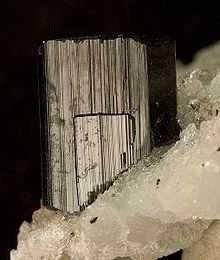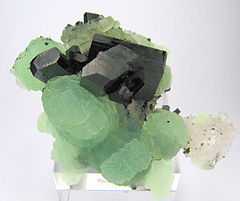Babingtonite
| Babingtonite | |
|---|---|
|
Triclinic crystals of babingtonite with prehnite, from Qiaojia, Qiaojia Co., Zhaotong, Yunnan, China (size: 71 mm x 55 mm, 71 g) | |
| General | |
| Category | Inosilicate |
| Formula (repeating unit) | Ca2(Fe,Mn)FeSi5O14(OH) |
| Strunz classification | 09.DK.05 |
| Identification | |
| Color | Dark green to black |
| Crystal habit | Prismatic crystals |
| Crystal system | Triclinic |
| Cleavage | Perfect on {001}, Good on {010} and {100} |
| Fracture | Irregular/uneven |
| Tenacity | Brittle |
| Mohs scale hardness | 5.5 to 6 |
| Luster | Vitreous |
| Diaphaneity | Translucent on thin edges, opaque |
| Specific gravity | 3.3 |
| Refractive index | nα= 1.700 nβ= 1.710 nγ= 1.725 |
| Birefringence | δ = 0.025 |
| Pleochroism | Visible |
| Dispersion | r > v strong |
| References | [1] |
Babingtonite is a calcium iron manganese inosilicate mineral with the formula Ca2(Fe,Mn)FeSi5O14(OH). It is unusual in that iron(III) completely replaces the aluminium so typical of silicate minerals. It is a very dark green to black translucent (in thin crystals or splinters) mineral crystallizing in the triclinic system with typically radial short prismatic clusters and druzy coatings. It occurs with zeolite minerals in cavities in volcanic rocks. Babingtonite contains both iron(II) and iron(III) and shows weak magnetism. It has a Mohs hardness of 5.5 to 6 and a specific gravity of 3.3.
It was first described in 1824 from samples from Arendal, Aust-Agder, Norway (which is its type locality) and was named after the Irish physician and mineralogist William Babington (1757–1833).[2]
It is the official mineral (mineral emblem) of the Commonwealth of Massachusetts.[3]
References
- ↑ http://www.mindat.org/min-478.html Babingtonite at Mindat.org
- ↑ http://webmineral.com/data/Babingtonite.shtml Webmineral
- ↑ Massachusetts: Mineral or mineral emblem of commonwealth

| Wikimedia Commons has media related to Babingtonite. |
| ||||||||||||||||||||||||||||||||||||
